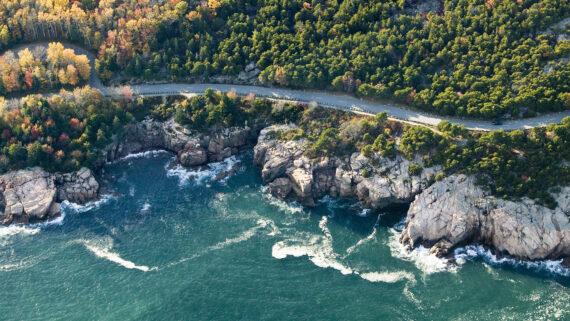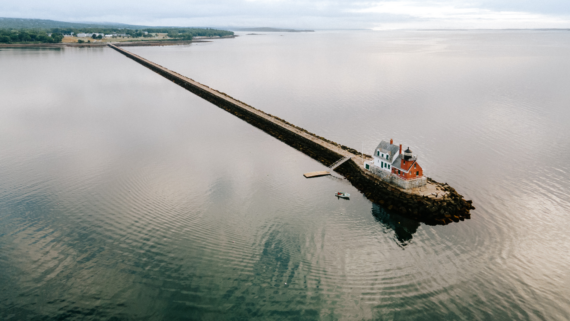
Ghost of a Chance
Catching a glimpse of a ghost orchid is rare, but even rarer is the multiple blooms this mysterious flower continues to produce in Naples’s swamps.
By Jason Fitzroy Jeffers
“Can you see it?” asks RJ Wiley, pointing high up into the dense tangle of trees in the swamp before me.
I squint and take a look. Nothing.
For the last 20 minutes or so, we’ve been walking along a wooden boardwalk that snakes deep into the western edge of the Everglades, past mesmerizing flowers, trees, and insects that look like they seemingly time warped from the Jurassic period. My mission here today at Corkscrew Swamp Sanctuary in Naples is to set my eyes on the “super ghost” orchid, one of the rarest flowers in existence of the world, which has attracted scientists and flower fans from all over the world since it was first discovered seven years ago. And apparently, the summer of 2014 marked the super ghost’s best and most prolific blooming period. During my drive here, I tried calling up different possibilities of what it might look like. Ethereal, perhaps with lush unfolding petals the size of palm fronds? Maybe even radiating some sort of white glow from some unknown, inner mystical light source?
Now I’m here, and I can’t even see it. The flower is wrapped around an old cypress about 60 feet up, 100 feet away from the boardwalk. Any part of me that is tempted to get a closer look is dissuaded by the fact that I’d be dangling my toes as some prized gator bait here in this stretch of federally protected swamplands.
“Here,” motions Wiley handing me his Nikon D3X. He’s not just a self-proclaimed “ghost hunter,” visiting the super ghost weekly, sometimes daily, but a wildlife photographer who captured the first-ever pictures of the flower seven years ago. His images of this particular plant have been published all over the world, earning him Audubon 2012 “Florida’s Photographer of the Year.” He eagerly motions me to peer through the lens, in the hope it will give me a better look. It takes a minute, but then, there it is: a delicate wisp of roots entwined around the thick trunk of the tree. Whatever flowers were there have fallen away, and the few tiny buds left aren’t even open yet. Sensing my disappointment, Wiley pats me on the back. “It might bloom again in the next few weeks,” he says, “but you never know.”
Throughout history, orchids have cast a rapturous spell on the human imagination. In ancient China, they were praised for their almost divine beauty and are still used in traditional Chinese medicine. In nineteenth-century England, the noble elite hired orchid hunters to plunder the Caribbean and South America. Today, thousands of orchid species thrive in the unique warm, humid environment of the Everglades. But of the all those species – from the butterfly to cigar orchid and the clamshell to night-scented orchid – the rarest and most prized is Dendrophylax lindenii, aka the ghost orchid. Discovered in Cuba in the 1840s and found half a century later in the Florida Everglades, some say it received its name due to how elusive it is, like a phantom.
In July 2007, the crown jewel of the orchid kingdom was found at Corkscrew when horticulturalist Maryanne Biggar spied an owl through her binoculars. In the same glance, she spotted a cluster of white in the high branches of a cypress. She focused in, only to see the largest cluster of white ghost orchid flowers on one plant ever recorded in history.
“Most ghost orchids out in the rest of the swamp system sometimes have one or two flowers,” says Mike Owen, park biologist at Fakahatchee Strand Preserve State Park, considered by many enthusiasts to be the orchid capital of the United States.
“Anytime you see a ghost orchid in the wild, it means it basically won the lottery,” says Owen, stressing just how much of a “stars-aligned” situation it requires. “Its seed had to land in the right spot. The temperature had to be just right, the sunlight had to be just right, and the fungi had to be just right. Then one of the flowers it shoots out after 16 to 17 years has to be pollinated by the giant sphinx moth, the only species we know that can pollinate it. The odds are overwhelmingly stacked against it.”
Within days, the discovery of the “super ghost” had sparked a frenzy. A story of the find was soon published by the Associated Press in newspapers around the world.
“Our summer season is generally quite slow. I’d say we tripled our attendance that summer because of it,” says Jason Lauritsen, sanctuary director at Corkscrew.
I’m far from a flower enthusiast, but as I walk the rest of the boardwalk, taking in the bewitching lilies, 600-year-old-trees, and alien-looking butterflies and grasshoppers, I can appreciate how this flower has almost come to serve as a symbol of this ancient, natural beauty that is becoming harder to find in the world today. I may not have seen the flower, and I guess I should be disappointed, but, in fact, I feel quite the opposite; I’m more intrigued than I was before. It’s unusual multiple blooms have produced flowers every summer, which is exactly why I plan to come back next year.
Where to Stay Edgewater Beach Hotel




